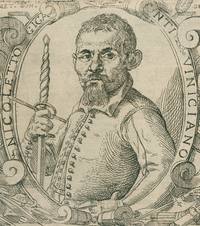|
|
You are not currently logged in. Are you accessing the unsecure (http) portal? Click here to switch to the secure portal. |
Nicoletto Giganti
| Nicoletto Giganti | |
|---|---|
 | |
| Born | 1550-1560 Fossombrone, Italy |
| Died | after 1622 Venice, Italy (?) |
| Occupation |
|
| Nationality | Italian |
| Influenced | Bondì di Mazo (?) |
| Genres | Fencing manual |
| Language | Italian |
| Notable work(s) |
|
Nicoletto Giganti (Niccoletto, Nicolat; 1550s-after 1622[1]) was a 16th – 17th century Italian soldier and fencing master. He was likely born to a noble family in Fossombrone in central Italy,[2] and only later became a citizen of Venice as he stated on the title page of his 1606 treatise. Little is known of Giganti’s life, but in the dedication to his 1606 treatise he counts twenty seven years of professional experience (possibly referring to service in the Venetian military, a long tradition of the Giganti family).[3]
In 1606, Giganti published an enormously populate treatise on the use of the rapier (both single and with the dagger) titled Scola, overo, Teatro ("School or Fencing Hall"). The treatise is structured as a series of progressively more complex lessons, and Tom Leoni opines that this treatise is the best pedagogical work on rapier fencing of the early 17th century.[4] Several times in his 1606 treatise Giganti promised to publish a second volume with more material, but this treatise was considered lost for centuries and as early as 1673 the Sicilian master Giuseppe Morsicato Pallavicini stated that this second book was never published at all.[5]
Contents
Treatise
| Images | No Translation |
Italian (1606) | German (1619) | French (1619)
|
|---|---|---|---|---|
Additional Resources
- Leoni, Tom. Venetian Rapier: The School, or Salle. Nicoletto Giganti's 1606 Rapier Fencing Curriculum. Wheaton, IL: Freelance Academy Press, 2010. ISBN 978-0-9825911-2-3
References
- ↑ Leoni, p xii.
- ↑ Lancellotti, Francesco Maria. Quadro letterario degli uomini illustri della città di Fossombrone. In Colucci, Giuseppe. Antichità picene, XXVIII. Fermo, 1796. p 33.
- ↑ Calcaterra, Francesco. Corti e cortigiani nella Roma barocca. Rome, 2012. p 76.
- ↑ Leoni, p xii.
- ↑ Pallavicini, Giuseppe Morsicato. La seconda parte della scherma illustrata. Palermo, 1673. p v.

